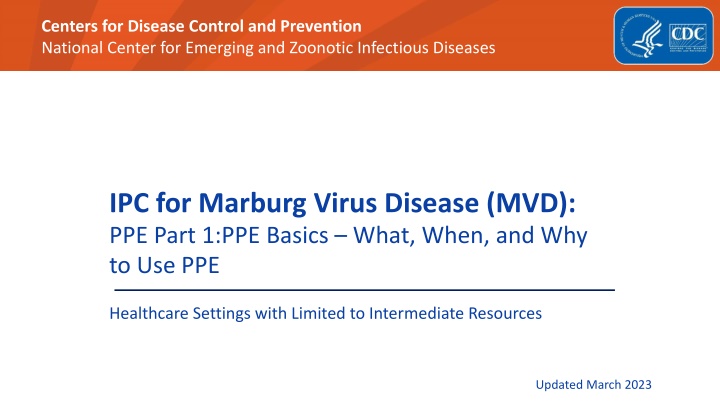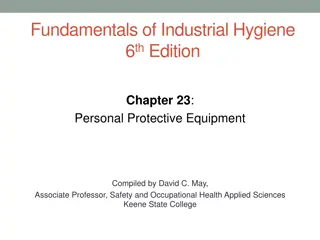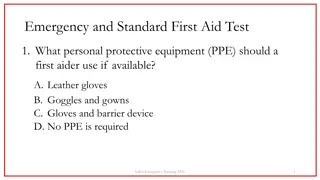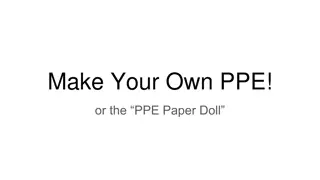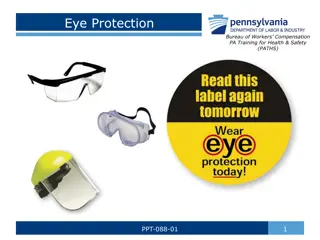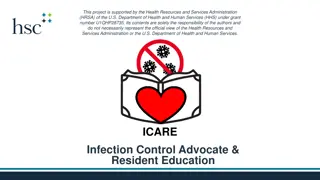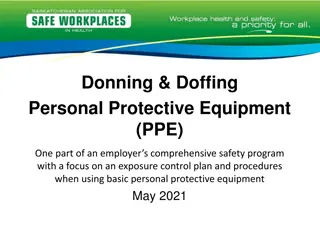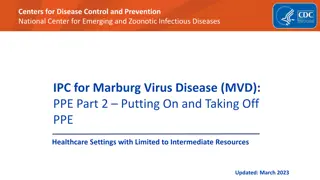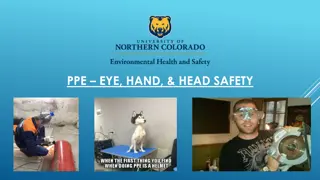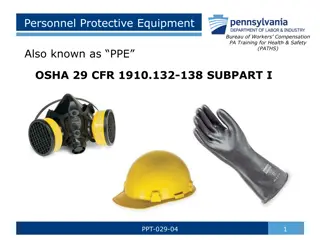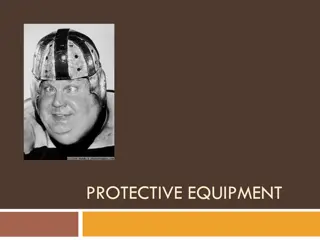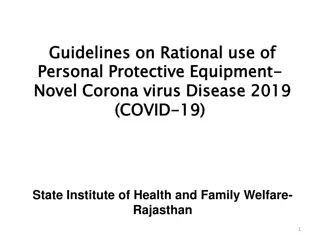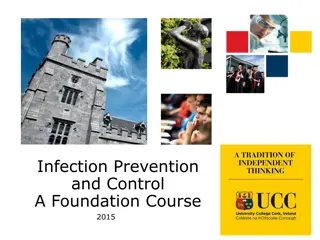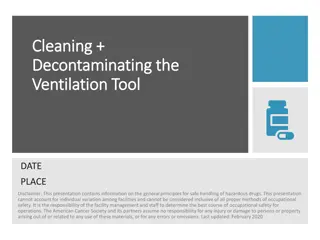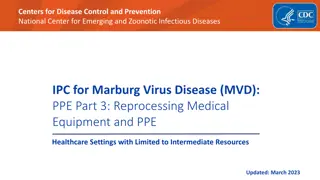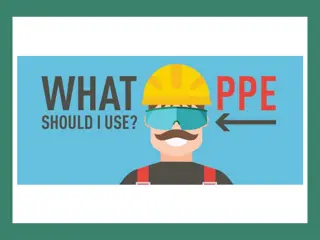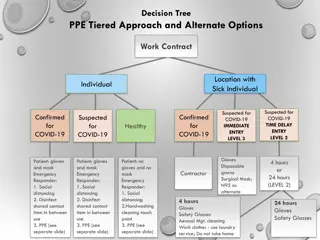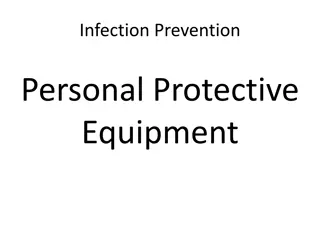Importance of Personal Protective Equipment (PPE) in Healthcare Settings
Personal Protective Equipment (PPE) is essential in preventing the spread of infectious diseases like Marburg virus. PPE includes specialized clothing and equipment that create barriers to protect healthcare workers from patient's body fluids. This article covers the definition of PPE, its items, importance in preventing transmission, and guidelines on when to use PPE in healthcare settings with limited resources. Understanding and correctly using PPE is crucial for healthcare workers to safeguard themselves and prevent the spread of diseases.
Download Presentation

Please find below an Image/Link to download the presentation.
The content on the website is provided AS IS for your information and personal use only. It may not be sold, licensed, or shared on other websites without obtaining consent from the author.If you encounter any issues during the download, it is possible that the publisher has removed the file from their server.
You are allowed to download the files provided on this website for personal or commercial use, subject to the condition that they are used lawfully. All files are the property of their respective owners.
The content on the website is provided AS IS for your information and personal use only. It may not be sold, licensed, or shared on other websites without obtaining consent from the author.
E N D
Presentation Transcript
Centers for Disease Control and Prevention National Center for Emerging and Zoonotic Infectious Diseases National Center for Emerging and Zoonotic Infectious Diseases Centers for Disease Control and Prevention IPC for Marburg Virus Disease (MVD): PPE Part 1:PPE Basics What, When, and Why to Use PPE Healthcare Settings with Limited to Intermediate Resources Updated March 2023
Learning Objectives Learning Objectives After this presentation, participants will be able to Explain why PPE is important in the context of Marburg virus disease Choose appropriate PPE for certain activities Identify if PPE is being used correctly
What Is Personal Protective Equipment (PPE)? What Is Personal Protective Equipment (PPE)?
Definition: PPE Definition: PPE PPE is specialized clothing or equipment worn by healthcare workers that provides barriers or layers to protect their eyes, nose, mouth, skin, and clothing from contact with a patient s body fluids (blood, vomit, urine, stool, or sweat). Correct use of PPE helps protect you from infection.
PPE Items PPE Items Head covering Goggles Mask Face shield Head + hair Eyes Nose + Mouth Eyes + Nose + Mouth Gown Coverall Boots Gloves Apron Body Feet Hands Body Body
Why PPE? Why PPE? Marburg virus disease can spread through direct contact (such as through broken skin or mucous membranes in the eyes, nose, or mouth) with Blood or other body fluids of a person who is sick with or has died of Marburg virus disease Objects contaminated with blood or other body fluids from a person who is sick with or has died from Marburg virus disease. PPE works as a barrier to protect your eyes, nose, mouth, skin, and clothing from contact with a patient s body fluid.
When to Use PPE When to Use PPE
Standard Precautions Standard Precautions Used for all patient care Protect healthcare workers from infection and prevent the spread of infection from patient to patient Cover coughs / respiratory hygiene Hand hygiene Personal protective equipment (PPE) based on risk of exposure Clean and disinfect patient care equipment and instruments Clean and disinfect healthcare environment Safe injection practices Sharps safety Handle textiles and linens carefully
Key Point on PPE Key Point on PPE PPE alone is not enough. Safe patient care during a Marburg virus disease outbreak requires all standard precautions including: Hand hygiene Environmental cleaning Screening and isolation
PPE and Standard Precautions during Marburg Virus PPE and Standard Precautions during Marburg Virus Disease Outbreak Disease Outbreak It is not always possible to clearly identify patients with Marburg virus disease because early symptoms are nonspecific. Because of this, during an Marburg virus disease outbreak, use Standard Precautions for any care or activities that might allow exposure to blood or other body fluids. Note: Gloves should be considered if you will be touching patient
PPE PPE for Marburg Virus Disease for Marburg Virus Disease Screening Screening Screening can be a non-contact activity Maintain distance of at least 1 meter Avoid direct face-to-face interaction (physical separation such as plexiglass preferred) If distance can be maintained PPE not required If distance can t be maintained Mucous membrane protection (goggles + face mask OR face shield + face mask) Single gloves Gown PPE PPE for screening when distance cannot be maintained If PPE is worn remove after each person you screen + perform hand hygiene
PPE for Patient Care & Environmental Cleaning PPE for Patient Care & Environmental Cleaning Hood covers the neck and shoulders, worn over mask Goggles or face shield Double gloves (inner pair and outer pair) Gown OR coverall Apron Head cover Waterproof boots Mucous membrane protection (face mask* + face shield) OR (face mask* + goggles) Mask Disposable suit is secured with front zipper Second pair of surgical or rubber gloves Surgical gloves Apron covers from neck to below the knees *Respirator can be used in place of face mask (structure of respirator keeps it from collapsing when soaked with sweat; may be preferred in hot, humid climates) Rubber boots
Using PPE Correctly Using PPE Correctly
Key Point on PPE Key Point on PPE (Reminder) (Reminder) PPE helps protect you from infection but PPE only works if it is used correctly every time.
Dos and Donts While Wearing PPE Do s and Don ts While Wearing PPE DO DON T Change PPE that is heavily contaminated with blood or other body fluids Touch or adjust PPE once it s on Touch your face Touch unnecessary objects, such as cell phones, pens, patient charts Change PPE if it gets damaged (e.g., glove tears, gown rips) Touch surfaces such as bed rails, counters unless absolutely necessary Remove PPE correctly and carefully, even when you're tired
What if PPE is limited? Prioritize PPE use for: Cleaning staff Any patient interaction with potential for exposure to body fluids, especially blood (e.g., maternity and trauma patients) Rememberthat PPE is one aspect of Standard Precautions: Maintain at least 1 meter distance (e.g., neutral space for passing medication) Perform hand hygiene as indicated Identify solutions based on local context (adaptations to procedures and clothing)
Knowledge Check: PPE Knowledge Check: PPE Imagine these are your co-workers. Based on what you know about proper use of PPE, what suggestions would you give them in each of these scenarios to help them better protect themselves? 1 2
Feedback: PPE Feedback: PPE Picture 1: PPE worn out of context Face mask not worn correctly - ensure mask covers nose and mouth; adjust to fit Overly soiled gloves need to be removed Picture 2: Touching coverall hood and sides of face mask with gloved hands Coverall hood not fully covering hair Mask not covering nose No eye protection
Reflection Reflection Have you experienced a shortage or lack of PPE in your healthcare facility before? If so, what did you and your co- workers do to protect yourselves despite limited PPE? In the context of Marburg virus disease, what are some adaptations you might consider in your facility if PPE is limited?
Key Takeaways Key Takeaways PPE helps protect you from infection. Protecting yourself helps protect your patients and your community. But PPE only works if it is used correctly. PPE is just one aspect of Standard Precautions. Hand hygiene, environmental cleaning and disinfection, and other precautions are key to helping keep you, your patients, and your community safe.
Thank you! For more information, contact CDC 1-800-CDC-INFO (232-4636) TTY: 1-888-232-6348 www.cdc.gov TTY: 1-888-232-6348 www.cdc.gov For more information, contact CDC 1-800-CDC-INFO (232-4636) The findings and conclusions in this report are those of the authors and do not necessarily represent the official position of the Centers for Disease Control and Prevention. official position of the Centers for Disease Control and Prevention. The findings and conclusions in this report are those of the authors and do not necessarily represent the
